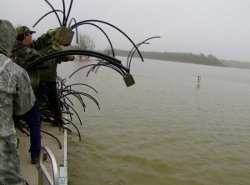|
sponsored by
Zeiner's Angler Supply
The Kansas Angler Online
and Swim Tail Lures |
Oklahoma youth create fish habitat and contribute to better angling
 February 26, 2010 - (Photo) Students from Valliant Schools recently teamed up with the Wildlife Department to construct 200 fish attractors called spider blocks, and members of the Pushmataha County Sportsmens Club helped place the bush-like structures into Pine Creek Lake. February 26, 2010 - (Photo) Students from Valliant Schools recently teamed up with the Wildlife Department to construct 200 fish attractors called spider blocks, and members of the Pushmataha County Sportsmens Club helped place the bush-like structures into Pine Creek Lake.
Youth involved in FFA and agricultural classes at Valiant Schools recently teamed up with the Oklahoma Department of Wildlife Conservation and the Pushmataha County Sportsmens Club to give a southeast Oklahoma fishery a boost.
The students constructed artificial fish attractors called spider blocks that can provide areas of concentrated fish for anglers to catch. The blocks consist of plastic tubing attached to concrete blocks that serve as cover for fish that, unlike trees and some natural habitat, will not break down over time. The bush-like spider blocks sink to the lake floor and provide cover for predatory fish as well as smaller fish.
The students assembled 200 spider blocks, which were placed in Pine Creek Lake with the help of members from the Pushmataha County Sportsman Club.
Projects like the one at Pine Creek have been conducted all over the state with the help of students, resulting in the construction and placement of thousands of spider blocks in lakes.
Some of the schools that have helped with spider block projects include Eufaula, Canadian, Crowder, Indianola, Porum, Moss, Holdenville, Byng, Stonewall, Latta, Roff, Allen, Calera, Kingston, Madill and others.
This effort has really been popular with the schools and has given them a chance to help enhance fishing, said Danny Bowen, central region fisheries biologist for the Wildlife Department.
Participating students can directly benefit from the projects. South-central region Fisheries Supervisor Matt Mauck said many of the spider blocks are placed in lakes nearby where the students live so they can fish in those locations and see the results of their work. Mauck added that local angler groups, like the Pushmataha County Sportsmens Club, often help in the placement of spider blocks, making each project a true group effort.
Bowen said the Wildlife Department received a grant from the National Fish and Wildlife Foundation through the B.A.S.S. Federation Nation that has helped fund materials for spider blocks in lakes all over the state.
Habitat enhancement projects conducted at lakes also can work on private farm ponds. Spider blocks can be made affordably and placed in strategic locations, and other approaches work as well, such as sinking downed cedar trees. Invasive red cedar trees spread fast and, for the amount of nutrients and space they take up, they offer very little in the way of benefits to wildlife. They compete with native grasses and do not offer any more habitat benefits than what can be found in non-invasive native trees. So one of the best places for cedar trees, if not treated with prescribed fire, is in the bottom of a farm pond or lake where fish will use them as cover. There, they will not only provide habitat, but will give anglers an idea of where to fish while wildlife benefits from their removal.
For more about fishing in Oklahoma, log on to wildlifedepartment.com.
Back to
Zeiner's Angler Supply | Kansas
Angler Online |
Swim Tail Lures
|